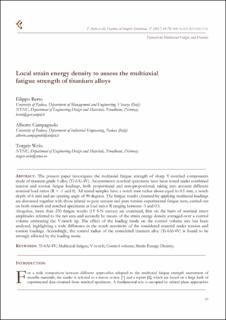| dc.contributor.author | Berto, Filippo | |
| dc.contributor.author | Campagnolo, Alberto | |
| dc.contributor.author | Welo, Torgeir | |
| dc.date.accessioned | 2020-06-05T12:26:10Z | |
| dc.date.available | 2020-06-05T12:26:10Z | |
| dc.date.created | 2016-08-16T12:53:54Z | |
| dc.date.issued | 2016 | |
| dc.identifier.citation | Frattura ed Integrità Strutturale. 2016, 10 (37), 69-79. | en_US |
| dc.identifier.issn | 1971-8993 | |
| dc.identifier.uri | https://hdl.handle.net/11250/2657011 | |
| dc.description.abstract | The present paper investigates the multiaxial fatigue strength of sharp V-notched components made of titanium grade 5 alloy (Ti-6Al-4V). Axisymmetric notched specimens have been tested under combined tension and torsion fatigue loadings, both proportional and non-proportional, taking into account different nominal load ratios (R = -1 and 0). All tested samples have a notch root radius about equal to 0.1 mm, a notch depth of 6 mm and an opening angle of 90 degrees. The fatigue results obtained by applying multiaxial loadings are discussed together with those related to pure tension and pure torsion experimental fatigue tests, carried out on both smooth and notched specimens at load ratios R ranging between -3 and 0.5. Altogether, more than 250 fatigue results (19 S-N curves) are examined, first on the basis of nominal stress amplitudes referred to the net area and secondly by means of the strain energy density averaged over a control volume embracing the V-notch tip. The effect of the loading mode on the control volume size has been analysed, highlighting a wide difference in the notch sensitivity of the considered material under tension and torsion loadings. Accordingly, the control radius of the considered titanium alloy (Ti-6Al-4V) is found to be strongly affected by the loading mode. | en_US |
| dc.language.iso | eng | en_US |
| dc.publisher | Italian Group of Fracture (IGF) | en_US |
| dc.rights | Navngivelse 4.0 Internasjonal | * |
| dc.rights.uri | http://creativecommons.org/licenses/by/4.0/deed.no | * |
| dc.title | Local strain energy density to assess the multiaxial fatigue strength of titanium alloys | en_US |
| dc.type | Peer reviewed | en_US |
| dc.type | Journal article | en_US |
| dc.description.version | publishedVersion | en_US |
| dc.source.pagenumber | 69-79 | en_US |
| dc.source.volume | 10 | en_US |
| dc.source.journal | Frattura ed Integrità Strutturale | en_US |
| dc.source.issue | 37 | en_US |
| dc.identifier.doi | 10.3221/IGF-ESIS.37.10 | |
| dc.identifier.cristin | 1373168 | |
| dc.description.localcode | F&SI operates under the Creative Commons Licence Attribution 4.0 International (CC-BY 4.0). This allows to copy and redistribute the material in any medium or format, to remix, transform and build upon the material for any purpose, even commercially, but giving appropriate credit and providing a link to the license and indicating if changes were made. Authors are allowed to retain both the copyright and the publishing rights of their articles without restrictions. | en_US |
| cristin.ispublished | true | |
| cristin.fulltext | original | |
| cristin.qualitycode | 1 | |

